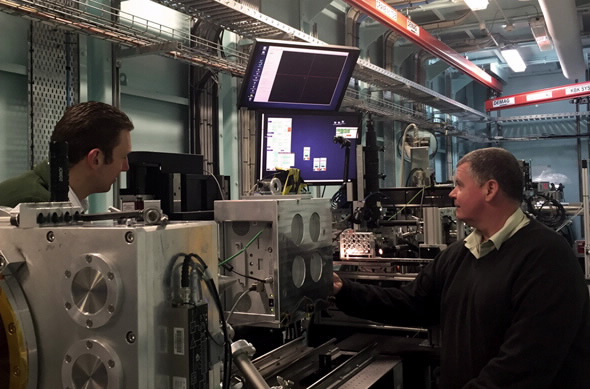The Australian Synchrotron has contributed to research that may end frequent eye injections for the treatment of severe vision impairment from macular degeneration.
 |
| Professor Ben Boyd (right) from Monash ARC Centre with Synchrotron scientist Dr Adrian Hawley (left) at the SAXS/WAXS beamline. |
Researchers at the ARC Centre of Excellence in Convergent Bio-Nano Science and Technology in Melbourne have worked with the Australian Synchrotron to develop a delivery system that releases a drug directly to the back of the eye to target macular degeneration, a progressive and often painful eye disease.
Led by Professor Ben Boyd from the ARC Centre and the Monash Institute of Pharmaceutical Sciences, the research is part of broader work at the nanoscale to develop miniature delivery systems that release drugs when they reach the targeted organ.
Using technology developed with researchers on the Australian Synchrotron’s small and wide angle X-ray scattering (SAXS/WAXS) beamline, the research team devised a delivery system that is switched on by pulses of light to unload its drug directly to the macula at the back of the eye.
The researchers use near-infrared light to open the nanopores of the material containing the drug at exactly the right locations. Because near-infrared light can penetrate tissue while keeping a straight path, it can be precisely targeted.
Macular degeneration is the leading cause of blindness and major vision loss in Australia with one in seven Australians over 50 experiencing some level of the disease. Patients with macular degeneration require regular drug injections into the eye. Professor Boyd says the procedure is invasive, and the more injections you have, the greater the risk of infection, scarring and retinal damage.
“A single injection that releases therapeutics is deployed when needed. Our research team is developing a delivery system that contains a drug that treats macular degeneration, such that when you shine light into the eye, a dose of the drug is released.
“It’s a quick, safe and easy alternative to the current treatment regime of frequent, repeated injections into the eye.”
The research team are also developing versions of this treatment that do not require any injection in the eye, but target the eye after intravenous or subcutaneous injection. The latter has been acknowledged as more favourable for patients and could potentially be self-administered at home.
Professor Boyd said the research was enabled by the powerful light source and expertise of the Australian Synchrotron.
“Working at the nanoscale, our experiments need to be precisely coordinated and our work would not have been possible without the accuracy and stability of the Australian Synchrotron’s very bright light.”
Published: 25/09/2015


